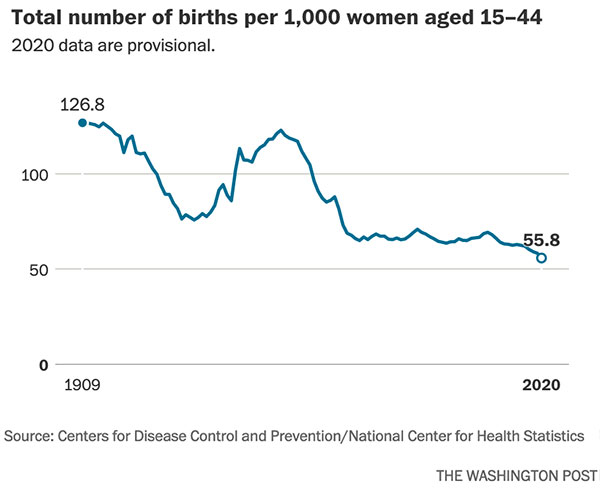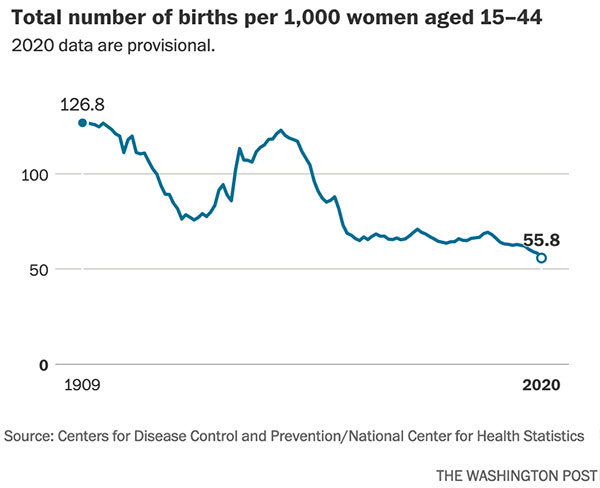The U.S. economy needs more kids. Parents say they want more kids. Yet the baby bust has gotten worse…
— from an op-ed by Catherine Rampell, “The baby bust won’t end without government action”, in the Washington Post, May 6, 2021
Once upon a time — long, long ago, it now seems — there was a “baby boom”.
Now we have a “baby bust”.
Not everyone wants to talk about it. In fact, the very phrase, “baby bust”, gives me a queasy feeling in my stomach. But facts must be faced, and if Ms. Rampell and I are the only reporters willing to discuss this ominous development, so be it. Like they always say about journalism: it’s a dirty job, but somebody has got to do it.
The following graph illustrates the gruesome story:
The story portrayed above is especially gruesome because it appears that one of the 1,000 women who did finally get around to giving birth in 2020, had only 0.8 of a baby. (As noted, the data for 2020 is provisional, so this could be a statistical error.)
We’re not clear why this chart begins in 1909. We know that, in 1909, Alice Huyler Ramsey, a 22-year-old housewife from Hackensack, New Jersey, became the first woman to drive a gasoline engine car across the US, covering 3,800 miles in 59 days. I’m not sure whether that has anything to do with the relatively large number of babies born that year, but perhaps it does.
Meanwhile, we know precisely why the chart ends in 2020 with 55.8 babies per 1,000 women of child-bearing age. The Washington Post is trying to make a point, so they picked the very lowest point in the past 111 years to locate end of their graph — obviously, to heighten the drama. American readers are especially sensitive to ‘low points’ on graphs, especially when the low point concerns babies. We are used to having our babies show up at the “high points” — high intelligence, high birth weight, high cost of Pampers, and so on.
It’s possible that this ‘low point’ is related to COVID quarantines, social distancing, and mask-wearing, all of which made sex a lot less fun. (Science has thoroughly documented a correlation between sex and babies.) But the birthrate had been declining rather steadily in the US, well before COVID arrived on the scene — in fact, dating back to about 1993. That was, of course, the year Bill Clinton was inaugurated as US President. (Another scientific correlation, awaiting documentation?)
The baby bust would probably generate little cause for concern, except for the fact that Americans have certain notions about the “ideal number of children for a family to have.” According to an historical survey done back in 1950, Americans then thought an “ideal family” should include about 4 children. (And two parents, I assume.)
When Gallup did a survey of Americans three years ago, they found that we now consider the “ideal number of children” to be somewhere between 2 and 3 kids. But at the rate women were having babies in 2020, most young families will end up with fewer than 2 kids. (And perhaps, fewer than two parents as well.) In other words, we’re headed for a whole slew of “non-ideal” families.
Also worrisome: the current rate is below “replacement rate”. Not that we thought our kids wanted to replace us — no one wants to think that — but the US needs our women to have each more than 2 babies, in order for the country to have a viable future — where enough kids are taking out college debt to keep our financial markets healthy. We also need young workers who actually earn paychecks, from which taxes can be deducted, in order to keep the Social Security system solvent.
And now that gay marriage is legal, well… we can all guess how that is going to play out, in terms of the birth rate.
Ms. Rampell suggests, in her Washington Post op-ed, that the ‘baby bust’ problem can be solved by government. (Meaning, the same government that made gay marriage legal?)
First would be a suite of changes that make it easier for Americans to have more kids. They include providing greater income security, so parents can afford to have the number of children they want. Also, adapting workplaces and other parts of the safety net so parents or would-be parents who want to stay in the labor force can do so more easily.
Where do smart people get their crazy ideas? I assume that Ms. Rampell is smart — she seems to have spelled everything correctly in her op-ed column — but I wonder, did she actually look at the chart she included in her essay?
During the year 1909, the US witnessed about 127 babies born per 1000 women. (Maybe “witnessed” isn’t exactly the right word, but you know what I mean.)
During the year 2020, the number was 55.8 per 1000 women.
Is this a “money problem”? Or something else?
In 1909, the average American worker earned less than $400 a year. (A dentist earned about $1,500, but not everyone can be a dentist.) Most families lived on Dad’s income, because Mom was home raising an average of about 4 kids. It appears that, in 1909, you could raise kids for about $100 each, per year.
In 2020, most households blessed with children have two incomes (although single parenting is becoming ever more popular.) That same family has, on average, less than 2 kids. The average household income in the US, for a family with kids, was about $78,000. That’s $39,000 per kid, in families with 2 kids. In families with 1 kid, that’s $78,000 per kid.
How much “greater income security” is Ms. Rampell talking about?
A more reasonable approach might be for the government to make sex enjoyable… like it used to be. How government can do that, I am not sure, but where there’s a will, there’s a way. Or so I’ve been told.
Underrated writer Louis Cannon grew up in the vast American West, although his ex-wife, given the slightest opportunity, will deny that he ever grew up at all.









